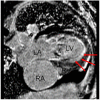Cardiovascular manifestations of hypereosinophilic syndromes
- PMID: 17868859
- PMCID: PMC2048688
- DOI: 10.1016/j.iac.2007.07.001
Cardiovascular manifestations of hypereosinophilic syndromes
Abstract
The hypereosinophilic syndromes (HESs) are characterized by persistent marked eosinophilia (>1500 eosinophils/mm(3)), the absence of a primary cause of eosinophilia (such as parasitic or allergic disease), and evidence of eosinophil-mediated end organ damage. Cardiovascular complications of HES are a major source of morbidity and mortality in these disorders. The most characteristic cardiovascular abnormality in HES is endomyocardial fibrosis. Patients who have an HES also may develop thrombosis, particularly in the cardiac ventricles, but also occasionally in deep veins. Because of the rarity of these disorders, specific guidelines for the management of the cardiac and thrombotic complications of HES are lacking. This article reviews the diagnosis and management of the cardiovascular manifestations of HES.
Figures







References
-
- Chusid MJ, Dale DC, West BC, Wolff SM. The hypereosinophilic syndrome: analysis of fourteen cases with review of the literature. Medicine (Baltimore) 1975 Jan;54(1):1–27. - PubMed
-
- Ommen SR, Seward JB, Tajik AJ. Clinical and echocardiographic features of hypereosinophilic syndromes. Am J Cardiol. 2000 Jul 1;86(1):110–113. - PubMed
-
- Parrillo JE, Borer JS, Henry WL, Wolff SM, Fauci AS. The cardiovascular manifestations of the hypereosinophilic syndrome. Prospective study of 26 patients, with review of the literature. Am J Med. 1979 Oct;67(4):572–582. - PubMed
-
- Ginsberg F, Parrillo JE. Eosinophilic myocarditis. Heart Fail Clin. 2005 Oct;1(3):419–429. - PubMed
-
- Cooper LT, Zehr KJ. Biventricular assist device placement and immunosuppression as therapy for necrotizing eosinophilic myocarditis. Nat Clin Pract Cardiovasc Med. 2005 Oct;2(10):544–548. - PubMed
Publication types
MeSH terms
Substances
Grants and funding
LinkOut - more resources
Full Text Sources
Medical

